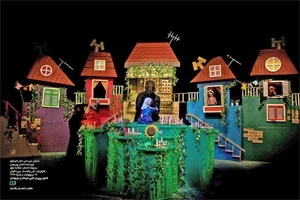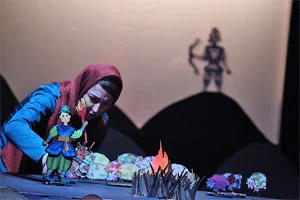THE PUPPET CENTER
FALL/WINTER 2014 ISSUE NO. 36
Table of Contents • Editor's Note • Selections
A Light in the Darkness
A glance on an Iranian Theatre and Puppet Theatre Center
by Salma Mohseni Ardehali
Introduction
The "Institute for the Intellectual Development of Children and Young Adults" (IIDCYA) known as "Kanoon"1, is an Iranian governmental organization which has been one of the most important accomplishments in Iran's contemporary cultural history. Kanoon was the response to the thirst for education in a developing country and to the need for providing a new generation of young Iranians with content and facilities for their intellectual development, leisure and recreation.
Kanoon was born in 1965. It is a center dedicated to the advancement of children's creativity and art education; it also provides and encourages quality productions of all types of books and various kinds of artistic works for children and young adults during their leisure time. The birth of what evolved to become Kanoon, owes so much to a group of young intellectuals, the most prominent among them being Leili Amir Arjomand (1938- ) and Firouz Shirvanlou (1938-1988) (Bakhtiari: 12).
Kanoon started its activities by establishing one library for children and publishing books for them. Shirvanlou's mind was occupied with the idea of expanding the institute's activities to encompass other realms such as making urban and rural mobile libraries as well as cinema centers and centers for musical productions. In 1968 Shirvanlou decided to invite the Circus of Moscow to Tehran with the intention of providing a part of the budget necessary for the inauguration of the cinema department of the institute. The institute gained sufficient revenue from the Circus project to launch its Cinema Center in 1970 (Bakhtiari: 23).
Gradually Kanoon became an institute with wide range of cultural and artistic activities for kids by producing books, tapes and records, toys, films, animated movies, theatre shows and other artistic and cultural productions "For" and "About" children.
Artistic-Cultural Centers (Libraries)
Foundation of libraries should perhaps be regarded as the most significant activity of the institute towards elevation of public culture. These libraries were well-spread all over the country and provided a proper place for the development of the children and young adults' talents and potentials. They were not only places for reading, but also a center for education and cultural interactions. In addition to permanent libraries, there are also some corresponding and itinerant libraries around the country. They have been presented over 40 activities, including storytelling, critical sessions and debate programs on various subjects as well as on library books, poetry recitation and poetical contests, holding various literary and artistic workshops such as painting, pottery, and calligraphy, screening films, preparing some bulletins, playing games like chess, acting out some plays based on the library books or plays written by library members (that had previously assessed and revised by institute writers and authorities), music classes, taking members to some field trips, and holding some galleries from their works (covering a wide range of activities from wallpaper magazines to illustrating library books).
Staging plays by library members, leaded Kanoon managers to establish a separate center for training theatre, performing and drama activities.
These days Kanoon has more than 750 libraries all over the country. In addition, there are 55 corresponding libraries, 47 mobile libraries for villages, and 12 mobile libraries for cities working throughout the country.2
Publishing Center
Kanoon publish center has been one of the most active center of this institute. During four decades, Kanoon has published more than 1500 titles, including some educational, scientific, literary, and religious subjects. These books have been regarded as prototypes due to their form and content. They include some English, Turkish, Arabic, Kurdish, Pashto, and Bosnian translations and some Brail versions. There have also been some film scripts, some play scripts for children, and some puppet plays by Iranian authors. There are also some guidebooks and proceedings books for children theatre trainers (e.g. "Take a look at theatre for children and young people of today" (Proceedings, 2012), "Story-play and its role and function in education" by Keighobad Yazdani-2011) and also some books for introducing theatre and puppet theatre to children (e.g. "Master of Kheimeh Shab Bazi is teaching" (1984), and "Puppet Theatre Step by Step" (1992) by Behrooz Gharibpour) and translated versions of some special reference books on theatre.
Kanoon Theatre and Puppet Theatre Center
The Kanoon Theatre Center was founded in December 1971 with focus on children and improvisational theatre. The primary goal of this center was to produce stage performances for children and young adults and offering children theatrical training. The center inaugurated in January, 1972 (Bakhtiari 128). At the outset the educational activities started at the site of the Central Library and some other libraries with theatrical trainings and rehearsals of plays like Radish and Kooti and Mooti by Bijan Mofid as theatrical samples. The team began acting under the supervision of a director of American origin, Don Laffoon, who was assisted by an assistant director and five actors. In 1975, after two years of activity, the center decided to apply a new educational method known as "theatre with kids" that was for the first time implemented in all Institute libraries. The first group of highly skilled trainers at the Theatre Center – all of whom were theatre graduates from the Faculty of Fine Arts and Faculty of Dramatic Arts – were employed in that year to start forming theatre classes for children and young adults at Kanoon libraries.
The method of "Theatre with Kids" was practiced under Ardavan Mofid's supervision. The main goal of these training courses for this particular age-group –besides dramatic education of teens and filling in the gap of theatrical literacy – was to enable teenagers to write stories and plays, direct plays and finally bring them on stage. Along with Radish and Kooti and Mooti, the play Rise Up Please, Lady Sun! by Reza Babak, was performed as touring theatre in 21 libraries of Tehran and 17 libraries of other cities (Bakhtiari 129). Apart from libraries, there were also special performances at hospitals, nurseries and other charitable institutions.
Another important initiative by Kanoon for promotion of theatre in small towns was the "Travelling Theatre Trailer". The vehicle was brought in from Germany by institute in 1973. The trailer had all facilities to perform any type of performance and even screen movies. In August, 1974 the first performances were staged on the trailer on the northern regions of Iran and covering a large number of cities and villages.
The Center for Puppet Theatre was created in 1972. Under the supervision and direction of a Czech puppeteer, Oscar Batek, this center organized the First Iranian Puppet Festival in 1975 (Rubin 269). The first puppet show—An Accident in the Puppet Town—was directed and staged by Batek. It was restaged a while later at the 25th Shahrivar Hall and then toured to libraries. Batek's Second performance called The Cloak of Thousand Tales premiered with the first professional cast of puppeteers (Bakhtiari 135). Center for Puppet Theatre of Kanoon has played an important role in the development and preservation of Iranian puppetry over the years.
In 1977, Behrooz Gharibpour who had gained some experience as an actor in children's puppet theatre directed some classes for young people in acting, directing, playwriting and criticism (Rubin 268). After the revolution in 1979, there was just Kanoon which would produce some puppet shows for children and adolescents and send them to its branches in Tehran and other cities of Iran and sometimes to other countries. In 1979, the first permanent venue for children theatre was established by Gharibpour in Kanoon by staging Koroglu-ye Chanli Bael at the institute's central library. The theatre launched under the name of Markaz-e Teatr va Teatr-e Aroosaki (Center for Theatre and Puppet Theatre) first with one hall and then, in 1981, a second venue was inaugurated. Gharibpour has been the manager of this center for nine great years (1980-89).
In the years after the Islamic Revolution, puppet productions have been one of the main concerns of Kanoon. Some of those that were working as directors in children's theatre and some of their productions include Nosrat Karimi (Unwanted Guest, 1985), Behrooz Gharibpour (Grandpa and Radish,1986), Ardeshir Keshavarzi (Stories from Kalīlah and Dimnah and Rumi's Masnavi,1981), Hasan Dadshekar (The Sparrow Ashi-Mashi, 1998), Hamid Abdolmaleki (Lily, Lily, Little Pool,1990), Kambiz Samimi (An Eye for an Eye, 1979) , Adel Bezdoudeh (Hey, who are you?, 1993), Davood Kianian (The Distressed Cockerel, 1993), Yadollah Vafadari (Little Lantern, 1980), Javad Zolfaqari (The Goat with Three Kids, 1983), and Vida Ghahremani (The Fish, 1995)3. And among the new generation we can mention some names such as Soheila Ahmadifar, Simin Amirian, Mohsen Imankhani, Afsaneh Zamani, Fahimeh and Sima Mirzahoseini, Maryam Kazemi, Hamed Zahmatkesh, Ali Pakdast, Maryam Eghbali and etc.
Joining ASSITEJ and UNIMA
Kanoon attended the 4th ASSITEJ (the International Association of Theatre for Children and Young People) meeting in Albania in 1972, and applied to join ASSITEJ. In 1973, Kanoon joined ASSITEJ and participated in ASSITEJ congress in West Berlin in 1974. Since then Kanoon has tried to be an active member, introducing the children's theatre and puppet theatre of Iran to the world. Kanoon also was the first Iranian member of UNIMA (Union Internationale de la Marionnette - International Puppetry Association). It joined UNIMA as a company in the 1970s.
Conclusion
Long after the revolution, Kanoon's Theatre Center was the most active theatre and puppet theatre center all over Iran. During the 1980s and early 1990s, puppet theatre for children was nearly the only application of puppetry in the country and many brilliant works were created at that time. Gradually, opinions evolved and more an a greater interest in puppetry for adults flourished.
Although there are still some great works occasionally produced and staged at Kanoon Theatre and Puppet Theatre Center, this center is really far from its glowing golden days. We can relate this wane to different factors such as mismanagement, lack of funding, devaluation of the importance of children's theatre, new tendencies in puppet theatre for adults, an inability to compete with today's mass media culture, a misunderstanding of audience expectations and so forth. As Kanoon has been active for some four decades in the field of cultural productions it has been regarded by Iranian schoolchildren, teachers and parents as a trustworthy name; the brand of "Kanoon" has been a guarantee of quality of the product; Authorities, managers and artists should be aware of this important point: people expect Kanoon to produce the perfect artworks. Now Kanoon Theatre and Puppet Theatre Center is struggling for survival although it might not be able to regain its power yet—neither to its primary state prior to the revolution, nor in the years following the revolution—but it is still a bright star in the dim sky of children's theatre and the puppet theatre of Iran.
Notes:
1- "Kanoon" is a Farsi word means "center".
2- These facts and figures are based on IIDCYA's different websites such as http://www.kanoonintl.com and will change over time.
3- These people have been the most active and effective artists and there have been a huge number of productions. For further information see the book "20 Years of Children Theatre (1979-1999)" by Tayyebe Esfandyari, 2002.
Bibliography:
1- Bakhtiari, Ali (Edited and Compiled). Iran: RPM, Collection of Iran's Vinyl Record Productions, vol II. London: Magic of Persia, 2014.
2- Esfandyari, Tayyebe. 20 Years of Children Theatre (1979-1999). Tehran: IIDCYA, 2002.
3- Rubin, Don. The World Encyclopedia of Contemporary Theatre: Volume 5: Asia/Pacific. Routledge, 2001.
4- ASSITEJ IRAN Bulletin. Tehran: IIDCYA, 2006.
5- Exclusive conversation with Behrooz Gharibpour on Kanoon and puppetry of Iran, 2014.
Websites:
http://www.kanoonintl.com/
http://kanoonnord.com/
http://www.hodhod.ir/
Weblogs:
www.puppet-art.blogfa.com
www.puppetart.webs.com
Salma Mohseni Ardehali is an Iranian Puppet scholar, Puppet Director and Manipulator. She has been a board member of Mobarak UNIMA since 2009.



